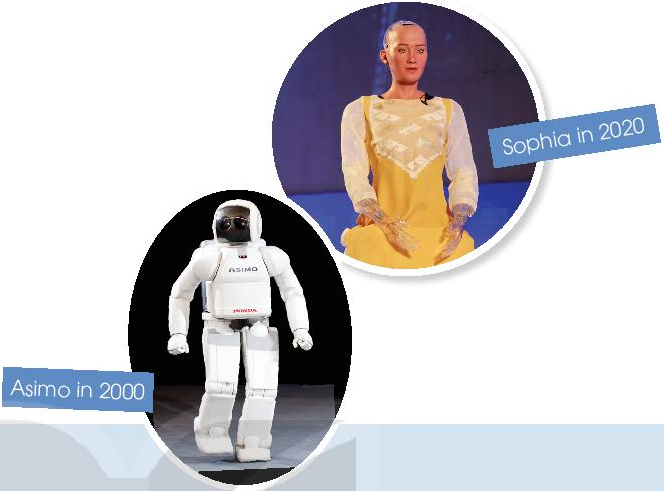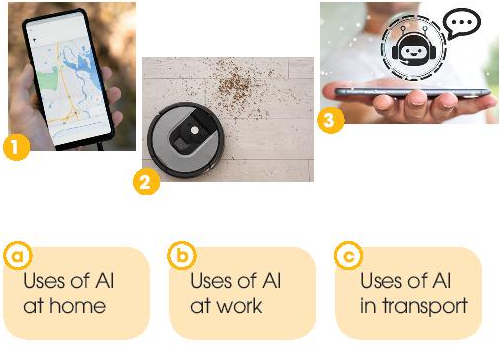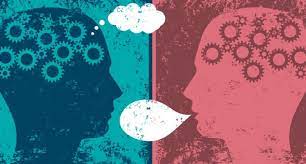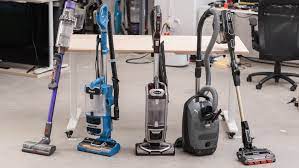Đừng bỏ lỡ những tính năng hấp dẫn của Baitap365.com
Unit 5: Inventions
1. Look at the pictures of Asimo and Sophia and discuss the questions below in pairs. 2. Read the text below and choose the best title for it. 3. Read the text again and match the pictures with the uses of AI. 4. Decide whether the following statement are true (T) or false (F). 5. Work in groups and discuss how AI can be used in schools. Then share your ideas with the whole class.
Bài 1
Artificial Intelligence (Trí tuệ nhân tạo)
1. Look at the pictures of Asimo and Sophia and discuss the questions below in pairs.
(Nhìn vào hình ảnh của Asimo và Sophia và thảo luận theo cặp các câu hỏi bên dưới.)
1. What are they? (Chúng là gì?)
2. What do you think they can do? (Bạn nghĩ chúng có thể làm gì?)

Bài 2
2. Read the text below and choose the best title for it.
(Đọc văn bản dưới đây và chọn tiêu đề tốt nhất cho nó.)
A. AI development over time
(Sự phát triển của trí tuệ nhân tạo theo thời gian)
B. Robots: The best AI inventions
(Người máy: Những phát minh trí tuệ nhân tạo tốt nhất)
C. AI in use today
(Sử dụng trí tuệ nhân tạo ngày nay)
D. AI in education
(Trí tuệ nhân tạo trong giáo dục)
In 2000, Asimo, a robot created by Honda, amazed everyone by just walking down the stairs. Twenty years later, a robot named Sophia can even communicate with people by using human language and expressing emotions.
However, robots are just one example of Artificial Intelligence (AI) – the study and development of machines that can copy human intelligence. Nowadays, Al has been applied to various areas of life.
At home, devices such as vacuum cleaners can now use AI to measure the room size and recognise any furniture. They can then decide on the most effective way to clean the house.
In transport, AI can be used on many smartphones to collect information about traffic. This can then help drivers find the most suitable route. Travelling has become much more convenient thanks to AI.
At work, the uses of AI are even more useful and exciting. Computer programmes, such as AI software or chatbots, can help customers plan their holidays, book flights and hotels, and answer questions.
AI is one of the most important inventions of the 21st century. It has completely changed our daily work and life.
Bài 3
3. Read the text again and match the pictures with the uses of AI.
(Đọc lại văn bản và ghép các hình ảnh với ứng dụng của AI.)

Bài 4
4. Decide whether the following statements are true (T) or false (F).
(Quyết định xem câu sau là đúng (T) hay sai (F).)
|
|
T |
F |
|
1. Sophia can show emotions when talking to humans. |
|
|
|
2. AI helps to make machines that think and act like humans. |
|
|
|
3. AI is one of the most important inventions of the 20th century. |
|
|
Bài 5
5. Work in groups and discuss how AI can be used in schools. Then share your ideas with the whole class.
(Làm việc theo nhóm và thảo luận về cách AI có thể được sử dụng trong trường học. Sau đó chia sẻ ý kiến của bạn với cả lớp.)
Từ vựng
1.
Artificial Intelligence /ˌɑːtɪfɪʃl.ɪnˈtelɪɡəns/ 

(n.phr): trí tuệ nhân tạo
However, robots are just one example of Artificial Intelligence (AI) - the study and development of machines that can copy human intelligence.
(Tuy nhiên, robot chỉ là một ví dụ của Trí tuệ nhân tạo (AI) - ngành nghiên cứu và phát triển các loại máy móc có thể sao chép trí thông minh của con người.)

2.
(n): người máy
In 2000, Asimo, a robot created by Honda, amazed everyone by just walking down the stairs.
(Năm 2000, Asimo, một người máy do Honda tạo ra, đã khiến mọi người kinh ngạc khi vừa bước xuống cầu thang.)

3.
human language /ˈhjuːmən ˈlæŋgwɪʤ/ 

(n.phr): ngôn ngữ loài người
Twenty years later, a robot named Sophia can even communicate with people by using human language and expressing emotions.
(Hai mươi năm sau, một robot tên là Sophia thậm chí có thể giao tiếp với con người bằng cách sử dụng ngôn ngữ của con người và thể hiện cảm xúc.)

4.
be applied to /biː əˈplaɪd tuː/ 

(v.phr): được ứng dụng
Nowadays, Al has been applied to various areas of life.
(Ngày nay, Al đã được ứng dụng vào nhiều lĩnh vực khác nhau của cuộc sống.)
5.
vacuum cleaners /ˈvækjʊəm ˈkliːnəz/ 

(n): máy hút bụi
At home, devices such as vacuum cleaners can now use Al to measure the room size and recognise any furniture.
(Tại nhà, các thiết bị như máy hút bụi giờ đây có thể sử dụng Al để đo kích thước phòng và nhận biết bất kỳ đồ nội thất nào.)

6.
(adj): hiệu quả
They can then decide on the most effective way to clean the house.
(Sau đó, họ có thể quyết định cách hiệu quả nhất để dọn dẹp nhà cửa.)
7.
collect information /kəˈlɛkt ˌɪnfəˈmeɪʃən/ 

(v.phr): thu thập thông tin
In transport, Al can be used on many smartphones to collect information about traffic.
(Trong giao thông, Al có thể được sử dụng trên nhiều điện thoại thông minh để thu thập thông tin về giao thông.)
8.
(n): tuyến đường
This can then help drivers find the most suitable route.
(Điều này sau đó có thể giúp người lái xe tìm ra tuyến đường phù hợp nhất.)

9.
(v.phr): nhờ có
Travelling has become much more convenient thanks to Al.
(Việc đi lại trở nên thuận tiện hơn rất nhiều nhờ có Al.)
10.
computer programmes /kəmˈpjuːtə ˈprəʊgræmz/ 

(n.phr): chương trình máy tính
Computer programmes, such as Al software or chatbots, can help customers plan their holidays, book flights and hotels, and answer questions.
(Các chương trình máy tính, chẳng hạn như phần mềm Al hoặc chatbots, có thể giúp khách hàng lên kế hoạch cho kỳ nghỉ của họ, đặt vé máy bay và khách sạn cũng như trả lời các câu hỏi.)
11.
(v.phr): cỗ máy
Al helps to make machines that think and act like humans.
(Al giúp tạo ra những cỗ máy suy nghĩ và hoạt động giống như con người.)

Mẹo tìm đáp án nhanh
Search Google: "từ khóa + baitap365" Ví dụ: "Bài 5 trang 13 SGK Vật lí 12 baitap365